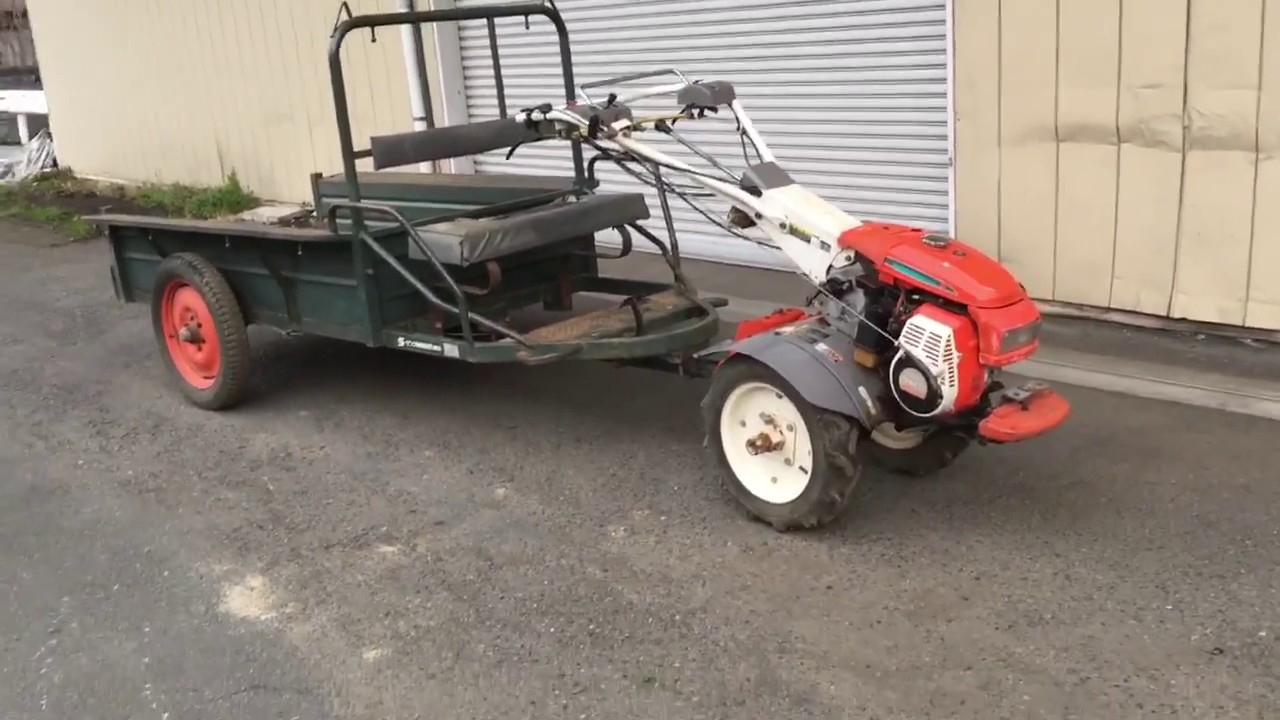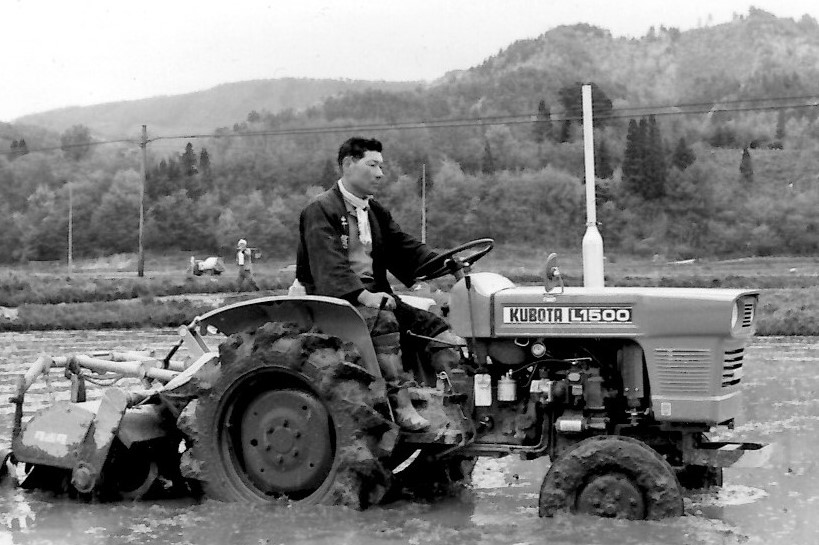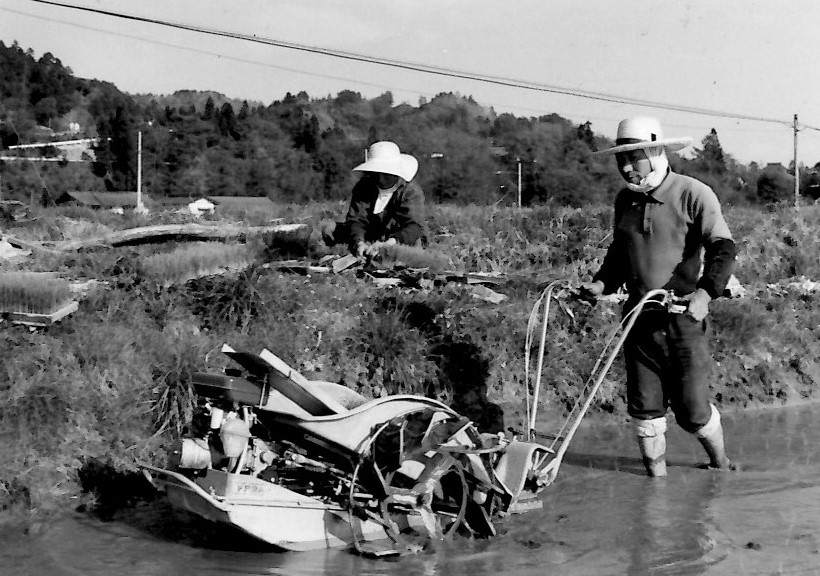By the way, the combine was named after combining binder (cut) and harvester
When I was a child, 'One horse-power' was popular, meaning that almost all farmers rely their field cultivation on the farm horse. In fact, own farm horse was treated as the family. Not only work in the field but also he/she was able to carry the cart for the cargo transportation. We have the name 'Karuma' in Omachi, which means 'lent the horse'. Horse power must be indispensable for the farming, however many farmers were too poor to buy the horse. Instead of buying, they used lent and borrow system, and 'Karuma' is the place where they did trading. Further back in time, when 'Salt Road' played an important role in the products exchange; trading of salt and sea foods with the mountain products, many horses must worked in carrying the cargo. 'Karuma' was like a transit port of 'lent and borrow' system.

Do you remember Japanese song such as 'Boku no namae wa Yanbo, bokuno namae wa Ma-bo, futari awasete Yan_Mar sa.....'? This is the commercial song of 'Yanmar', which is an leading company among the agricultural machinery manufacturer. This company is famous of its diesel engine development. In 1960th, the horse-power has displaced by the machinery-power. Yammer has developed small diesel engine, and the 2-wheeled cultivator caught the eye of farmers. At the same time, the small gasoline engine power was also used for the 2 wheeled vehicle.

The 2 wheeled vehicle, we call it as the 'Trailer', became popular not only for the field cultivation but also as the cargo carrier, regardless of diesel- or gas- powered. Afterword gas powered 'Trailer' spread over the farmland because of its lower price and high speed when driving the cart. Furthermore, it can be used for cultivation by changing the attachment from Trailer to the rotary cultivator. Nowadays, we missed this 2 wheeled-vehicle in Japan.

Tractor is a different concept in the machinery development between America and Japan. In Japan, 2 wheeled vehicle was the basic concept and inevitably changed to 4 wheeled vehicle. Because the efficiency of cultivation is correlated to the width of rotary cultivator, and the power up of engine followed. The bigger the engine, wheel base must be bigger, that is why 4 wheeled drive must be realized. In contrast to Japanese narrow land, American land usage is far beyond our imagination. In the process of pioneering history, the horse has been always accompanied in the land preparation. As the industrial revolution proceeded, the 4 legged horse was easily substituted by 4 wheeled engine. But there were various cultivators necessary for the horse based work. Even after the replacement with tractor, the horse based idea continued to produce equipment variation . Now, the tractor itself is almost the same between USA and Japan, but the equipment variation is few in Japan.
From this point of view, the history reaching to the tractor differ between USA and Japan. Again, the Japanese basis was hand hoe, and it was replaced by horse powered plow, followed by 2 wheeled power. Now 2 wheeled power was replaced by 4 wheeled tractor, while 4 legged horse was substituted by 4 wheeled tractor in USA. Thus, the process behind is a bit different.
This photo was taken almost 60 years ago. My father driven 15 horse powered tractor on that time. After 20 years later, when I worked in some field of Hokkaido, I used 30 horse powered engine, which was the largest on that time as a domestic production by Kubota, while John Deere tractor carried more than 100 horse powered engine. My 30 horse powered tractor was like a toy.
Now 100 horse powered tractor is also working in Japan, but the story behind is different. It is amazing and really an interesting.

Japanese modern agriculture has developed by way of new machinery. When I was a elementary student, we did transplanting rice by the hand. Actually we had a week of school holidays in May and October respectively. It is not a vacation but working days in rice field. Parents were waiting for these days, and let us work together in the field. Instead of taking these holidays, our summer vacation was shorter than those of urban school. Since transplanting must finish within a limited days, neighboring persons gathered to help each other. Once the first field was finished, then moved to the next field and to the nest, so on. The hand harvesting was almost the same: everybody worked for the first field then moved to the next. Since the first snow comes in the middle of October in this area 60 years ago, all harvest must be finished within short period. The 'Yui' system worked in a convenient way.
This scene has disappeared gradually along with the presence of 2 wheeled transplanting machine(see the photo), followed by 4 wheeled machine. Regarding its job efficiency, 2 rows-planting was popular. Soon later, 4 rows-planting appeared, and 6 rows- and 8 rows- planting becomes popular now. The timing of the change from hand-transplanting to the machinery was almost 60 years ago, when I was a junior high or high school student. The photo shows primary type driven by my father. According to my mother, she was better in machine-handling than my father, but she was not able to tell it to me because the father must be the Hero for the child.